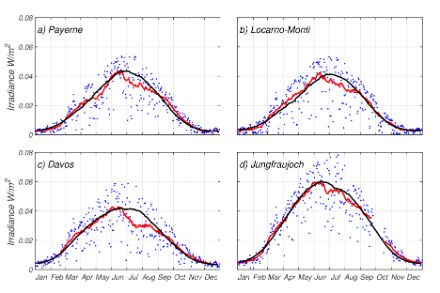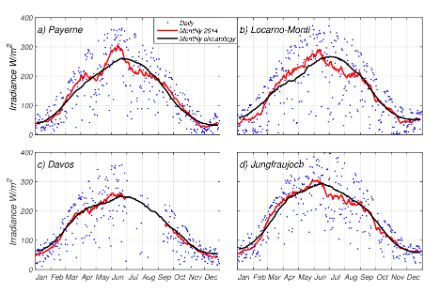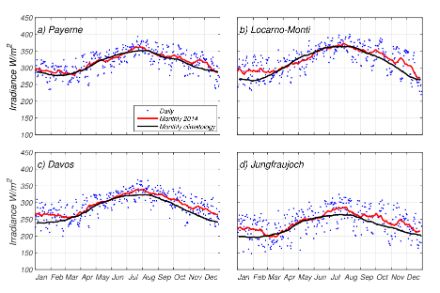Service Navigation
Search
Radiation is the driving force of energy exchanges between the atmosphere, the oceans and the surface of the earth. It is expected that the most direct effect of global warming will be a rise in infrared radiation from the atmosphere to the ground. Imbalances in the radiation budget are responsible for the dynamics of weather, and they also drive climate change. Minor differences between the incoming and outgoing radiation fluxes are already sufficient to start such processes. Consequently, long-term monitoring of surface radiation fluxes is an important component of climate change monitoring, which the weather service MeteoSwiss is actively cooperating to within the scope of the Global Atmosphere Watch Program (GAW).
Radiation throughout the year
At the stations in the Swiss Alpine Climate Radiation Monitoring network (SACRaM), MeteoSwiss measures radiation between the range of ultraviolet through visible radiation to infrared. The stations are located in Davos, Locarno-Monti, Payerne and on the Jungraujoch.
UV radiation and its influencing factors
UV radiation only accounts for a very small part of the sun's overall radiation intensity, but its wavelength is shorter than that of visible solar radiation, meaning its photons are more energetic. Thus UV radiation has a significant impact on human health. Excessive exposure to UV can cause damage to the skin and eyes (sunstroke, skin cancer, opacification of the eye lens). The intensity of UV radiation depends on a number of factors, including the solar elevation angle, cloud cover and reflected solar radiation, the latter of which is strongly affected by snow cover. The atmospheric ozone (Measurement of atmospheric ozone) also plays an important role in partially blocking UV radiation in the stratosphere and troposphere. The station at the highest altitude, situated on the Jungfraujoch, records the highest levels of UV radiation. This is due, among other things, to the thinner atmosphere at that altitude, as well as the fact that a large proportion of the station's surroundings is snow-covered all year round.
The highest UV radiation readings occur in the summer (June) and the daily averages are about0.06 W/m2 in Payerne, Locarno-Monti and Davos, and reaching 0.08 W/m2 at the Jungfraujoch. In winter, the values are much lower - in general by a factor of around ten.

The effects of cloud cover on shortwave and longwave radiation

The highest shortwave radiation readings occur in the summer (June) and their daily average are about 350 W/m2 in Payerne, Locarno-Monti and Davos, and reaching 400 W/m2 at the Jungfraujoch. In winter, the values are much lower - in general by a factor of around four.
In addition to the aforementioned factors, the intensity of solar radiation also depends on the concentration of aerosols (Aerosol monitoring) in the atmosphere, which is also referred to as aerosol optical depth. This is a measure of the transparency of the atmosphere. On the Jungfraujoch, for example, the aerosol optical depth is typically very low, but it is affected by strong disturbances such as the incursion of mineral dust from the Sahara or by local emissions from neighbouring valleys.
Cloud cover has a significant effect on both solar radiation as well as thermal radiation, although the effects on these two domains are generally opposite to each other. Although clouds more often than not reduce the intensity of solar radiation, they normally increase thermal radiation and retain the heat in the low layers of the atmosphere.
The highest longwave radiation values occur in the summer (at the end of July and in August) and are in the order of 400 W/m2 in Payerne and Locarno-Monti, 350 W/m2 in Davos and a little over 300 W/m2 on the Jungfraujoch. In winter, the values are much lower - in general around 200-250 W/m2.

Longer-term data series on UV radiation
MeteoSwiss has been measuring ultraviolet radiation since 1995 in Davos, since 1996 on the Jungfraujoch, since 1997 in Payerne, and since 2001 in Locarno-Monti. Given the considerable effects of UV radiation on health and ecosystems, it is important to have longer-term data series. Reconstruction methods exist that allow us to calculate UV radiation for past periods, based on ozone, the sun's angle of elevation, cloud cover and reflected radiation. Longer-term series of data are actually available for these parameters.
The reconstruction of UV radiation has been carried out on the basis of ozone measurements taken in Arosa and cloud in Davos, which date back to 1926. The results show that, on average, UV radiation fluctuated annually between 5 and 10 percent throughout the whole of the period. It was ozone and hours of sunshine that had the greatest effect, while changes in snow cover had only a small effect. The main cause of the increase in UV radiation since the end of the 1970s has been depletion of the ozone layer
- Vernez D., A. Milon, L. Vuilleumier, J.-L. Bulliard, A. Koechlin, M. Boniol and J. F. Doré. A general model to predict individual exposure to solar UV by using ambient irradiance data, (2014), Journal of Exposure Science and Environmental Epidemiology.
- Milon, A., Bulliard, J.-L., Vuilleumier, L., Danuser, B. and Vernez, D. Estimating the contribution of occupational solar UV exposure to skin cancer, (2014), British Journal of Dermatology, 170, 157–164
- Wacker, S., Gröbner, J. and Vuilleumier, L. (2013). A method to calculate cloud-free long-wave irradiance at the surface based on radiative transfer modeling and temperature lapse rate estimates. Theoretical and Applied Climatology, 1-11
- Nyeki, S., C. H. Halios, W. Baum, K. Eleftheriadis, H. Flentje, J. Gröbner, L. Vuilleumier, and C. Wehrli, (2012). Ground-based aerosol optical depth trends at three high-altitude sites in Switzerland and southern Germany from 1995 to 2010. J. Geophys. Res., 117, D18202
Wacker, S., J. Gröbner, D. Nowak, L. Vuilleumier and N. Kämpfer, (2011). Cloud effect of persistent stratus nebulosus at the Payerne BSRN site. Atmos. Res., 102:1, 1-9 - Vernez, D., Milon, A., Vuilleumier, L. and Bulliard, J.-L. Anatomical exposure patterns of skin to sunlight: relative contributions of direct, diffuse and reflected ultraviolet radiation (2012), British Journal of Dermatology, 167:2, 383-390
- Wacker, S., J. Gröbner, K. Hocke, N. Kämpfer and L. Vuilleumier, (2011). Trend analysis of surface cloud-free downwelling long-wave radiation from four Swiss sites. J. Geophys. Res., 116:D10, D10104
- Vernez, D., A. Milon, L. Francioli, J.-L. Bulliard, L. Vuilleumier and L. Moccozet, (2011). A Numeric Model to Simulate Solar Individual Ultraviolet Exposure. Photochemistry and Photobiology, 87:3, 721-728
- Gröbner, J., S. Wacker, L. Vuilleumier and N. Kämpfer (2009). Effective atmospheric boundary layer temperature from longwave radiation measurements. J. Geophys. Res., 114, D19116
- Nowak, D., L. Vuilleumier, C. N. Long, and A. Ohmura (2008). Solar irradiance computations compared with observations at the Baseline Surface Radiation Network Payerne site. J. Geophys. Res., 113, D14206
- Ruckstuhl, C., R. Philipona, K. Behrens, M. Collaud Coen, B. Dürr, A. Heimo, C. Mätzler, S. Nyeki, A. Ohmura, L. Vuilleumier, M. Weller, C. Wehrli, and A. Zelenka. (2008), Aerosol and cloud effects on solar brightening and the recent rapid warming. Geophys. Res. Lett., 35, L12708